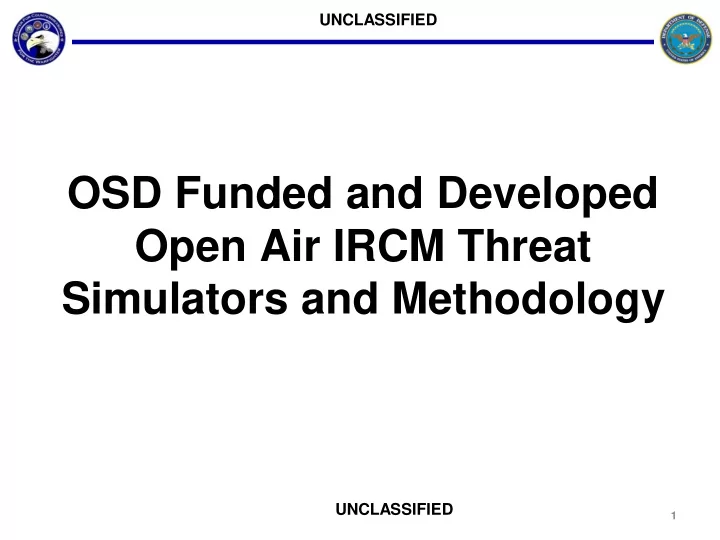

UNCLASSIFIED OSD Funded and Developed Open Air IRCM Threat Simulators and Methodology UNCLASSIFIED 1
UNCLASSIFIED Legacy Threat Stimulators • Legacy Missile Warning Sensors (MWS) typically required only stimulation, not simulation • Legacy stimulators typically provide a signal to “ring the bell,” not necessarily accurately simulate the threat UNCLASSIFIED 2
UNCLASSIFIED Modern MWS Systems • Modern MWS systems are more sophisticated and require threat- representative simulations for testing • Legacy stimulators typically cannot provide this level of fidelity • Simulators, not stimulators, are needed to produce threat- representative signals UNCLASSIFIED 3
UNCLASSIFIED Modern Threat Simulators • Three modern threat simulators exist or are being developed to provide threat-representative missile signatures – Joint Mobile Infrared Countermeasure Test System (JMITS) – Towed Airborne Plume Simulator (TAPS) – Multi-Spectral Sea and Land Target Simulator (MSALTS) – Under Development UNCLASSIFIED 4
UNCLASSIFIED Unifying Missile Simulator Programming Methodology • All three simulators follow the same missile simulator programming methodology UNCLASSIFIED 5
UNCLASSIFIED Joint Mobile Infrared Countermeasure Test System • CTEIP funded and developed in partnership with CCM • Ground-based stationary simulator • Simultaneous UV and dual color IR • Near real-time atmospheric and emitter degradation correction • Validated missile simulations include • Ejection spike • Ignition spike • Missile fly-out signature UNCLASSIFIED 6
UNCLASSIFIED JMITS Concept of Operation Open Air Installed IRCM Testing UNCLASSIFIED 7
UNCLASSIFIED JMITS Validation Report • JMITS validated by Test and Evaluation Threat Resource Activity (TETRA) • Validation report is available UNCLASSIFIED 8
UNCLASSIFIED JMITS Testing JMITS has been used extensively – More than 10,000 open-air simulations – Single & Dual JMITS system deployments – Coordination & testing with other missile simulators/stimulators – High valid signature yield (over 95% for recent test activities) UNCLASSIFIED 9
UNCLASSIFIED JMITS Programs Supported • JATAS • Navy DoN LAIRCM • Air Force C-17A LAIRCM PHII • Air Force CV-22 IOT&E • PICS • LAISM • Army HFIS • Department of Homeland Security UNCLASSIFIED 10
UNCLASSIFIED JMITS Hardware Overview UNCLASSIFIED 11
UNCLASSIFIED JMITS Flex-Play • Planned future capability • Development funded through OSD, TSWG • Ability to fire simulations based on positive aircraft position feedback • Results in more accurate simulations and a higher probability of achieving planned test parameters • Ability to conduct more realistic “unscripted” OT test scenarios UNCLASSIFIED 12
UNCLASSIFIED Quantum Cascade Lasers • Demonstration funded by T&E S&T • The S&T effort demonstrated integration of QCL lasers is possible and gives significant increase in power • Ongoing development task to insert the S&T demonstrated technology into JMITS to increase the available IR power • Lasers operated in CW mode with electro- mechanical modulation UNCLASSIFIED 13
UNCLASSIFIED Towed Airborne Plume Simulator • Development funded through CTEIP • Missile plume simulator that is towed behind an aircraft • IR simulation only • Provides spatially realistic operational environment in a IR clutter background • Meets most angular rate criteria of modern MWS spatial algorithms UNCLASSIFIED 14
UNCLASSIFIED TAPS UNCLASSIFIED 15
UNCLASSIFIED TAPS Concept of Operation UNCLASSIFIED 16
UNCLASSIFIED TAPS Towed Vehicle UNCLASSIFIED 17
UNCLASSIFIED TAPS Testing and Validation • TAPS will be used in support of the Air Force C-17A LAIRCM Phase II program • TAPS validation report is being completed UNCLASSIFIED 18
UNCLASSIFIED Multi-Spectral Sea and Land Target Simulator • Development contract awarded in December 2010 • Funded through CTEIP REP • Truly mobile ground-based simulator • Provide simultaneous UV and dual-color IR simulations while moving • Operate on land or on a ship in a littoral environment UNCLASSIFIED 19
UNCLASSIFIED MSALTS Design Concept UNCLASSIFIED 20
UNCLASSIFIED MSALTS Land Test Concept UNCLASSIFIED 21
UNCLASSIFIED MSALTS Sea Test Concept UNCLASSIFIED 22
UNCLASSIFIED MSALTS Technology • MSALTS will build on and use existing proven JMITS technology • Less manpower intensive than JMITS • Use QCLs for high power • Flex-play will be included in MSALTS UNCLASSIFIED 23
UNCLASSIFIED Missile Simulator Programming Methodology • JMITS, TAPS, and MSALTS are unified by a common methodology • Based on “SMEOS Programming Formulation”, the original programming methodology • Allows for commonality and comparison between test events • Methodology uses approved models and takes spectral responses and atmospherics into account UNCLASSIFIED 24
UNCLASSIFIED Methodology (continued) • Define missile simulation parameters – Missile type – Engagement geometry – One-to-one simulation or not • Generate fly-out model using Threat Modeling and Analysis Program (TMAP) UNCLASSIFIED 25
UNCLASSIFIED Methodology (continued) • Use Enhanced Missile Signature (E- MSIG) database to extract missile signature as a Source Radiant Intensity (SRI) in the SUT spectral response – Must know SUT spectral response UNCLASSIFIED 26
UNCLASSIFIED Methodology (continued) • Propagate the SRI signature through the simulated atmospheric conditions from the missile to the SUT – MODTRAN for IR, OSIC for UV • Result is irradiance on the SUT aperture in the SUT spectral band • This result is what the simulator must produce UNCLASSIFIED 27
UNCLASSIFIED Methodology (continued) • The simulator spectral band will most likely not be the same as the SUT band • Requires bandpass conversion from simulator to SUT • At time of simulation, account for current atmosphere UNCLASSIFIED 28
UNCLASSIFIED Normalization • During testing, small variations in the atmosphere and emitters occur which must be accounted for • A normalization measures these variations to account for them • Performed regularly throughout the test UNCLASSIFIED 29
UNCLASSIFIED Summary • JMITS, TAPS, and MSALTS constitute a set of modern, advanced missile plume simulation tools – OSD funded and developed • All three simulators are unified by a common missile simulator programming methodology UNCLASSIFIED 30
UNCLASSIFIED Contact Information R. David Hunter david.hunter@ccm.osd.mil Commercial: 575-678-7248 DSN: 258-7248 UNCLASSIFIED 31
UNCLASSIFIED Questions? UNCLASSIFIED 32
Recommend
More recommend